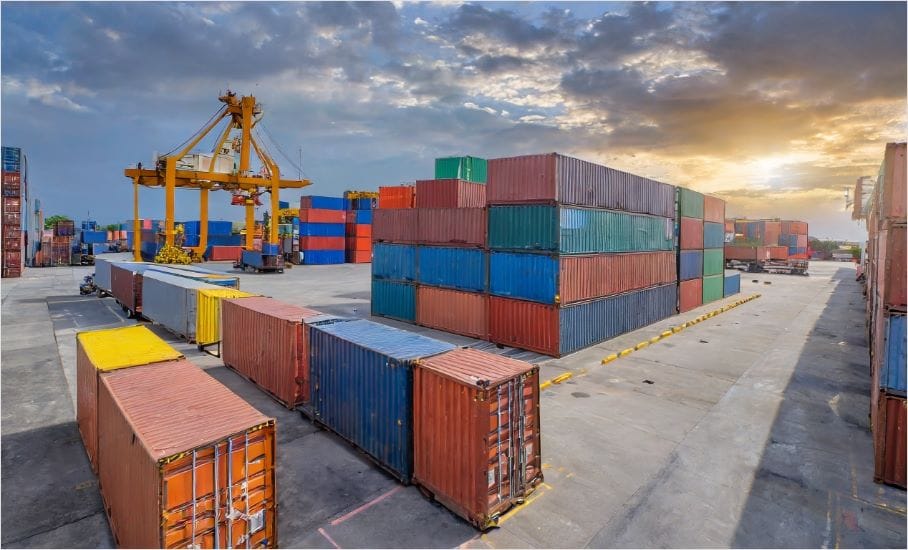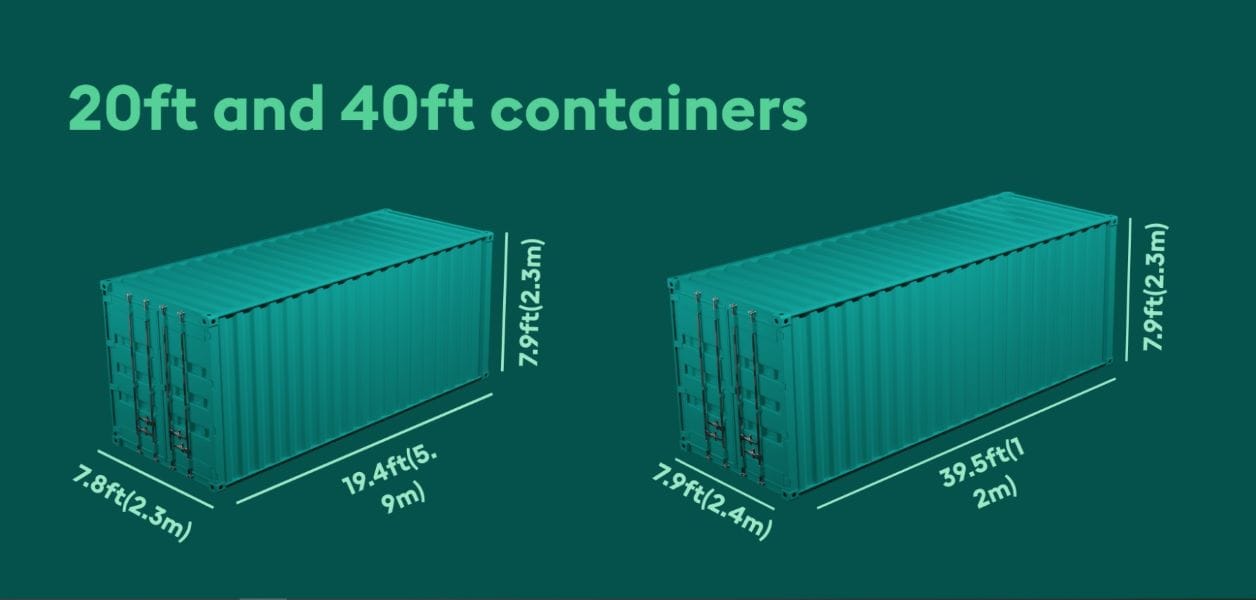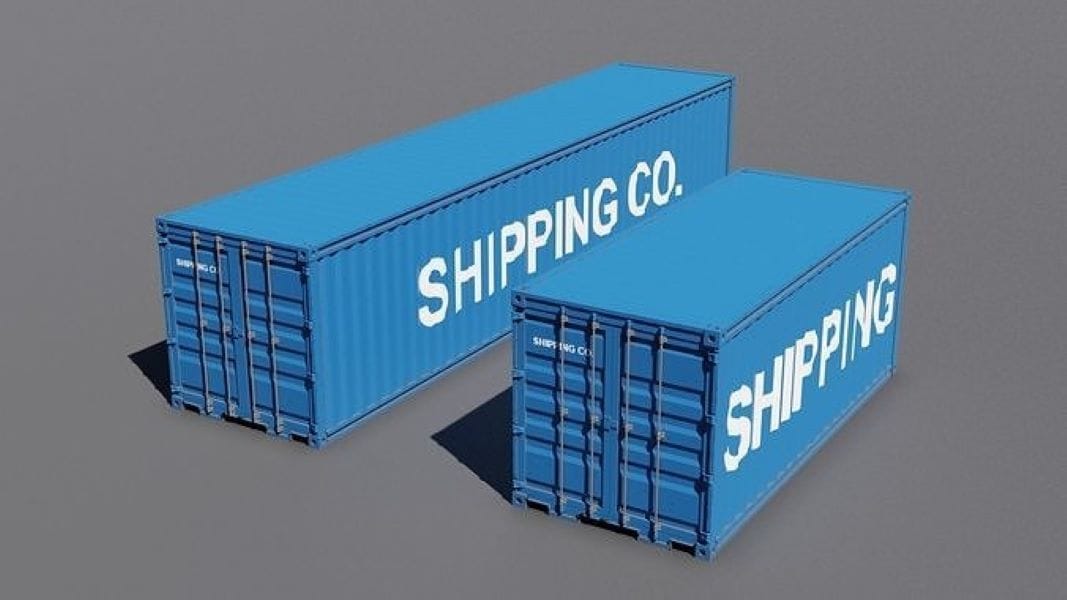20ft and 40ft containers are the most commonly used container types in international cargo transportation. They differ in size, capacity, applicable cargo types, etc., and are suitable for different transportation needs. This article will introduce the difference between the two in detail so that you can make a better choice in transportation.

Overview of 20ft and 40ft Containers
20ft containers and 40ft containers are standard containers that meet international standards and are convenient for loading and unloading and stacking worldwide. The container has a sturdy structure and is waterproof, moisture-proof, and anti-theft, making it suitable for various long-distance transportation methods such as sea and rail transportation.
It has brought great convenience to international trade and logistics transportation and is an indispensable choice in international trade and logistics transportation.
The Difference Between 20ft and 40ft Containers
The main difference between 20ft and 40ft containers is size and loading capacity. 20ft containers are usually used to transport small and medium-sized goods, while 40ft containers are used to transport large goods or more quantities of goods.
This size difference makes the two different in terms of transportation cost, space utilization, and cargo adaptability.
| Container type | Length (m) | Width (m) | Height (m) | Volume (m3) | Maximum load (tons) |
| 20ft container | 6.06 | 2.44 | 2.59 | 33 | 21 |
| 40ft container | 12.19 | 2.44 | 2.59 | 67.7 | 28 |

Shipping Costs and Timeliness for 20ft and 40ft Containers
- Unit cost: The shipping cost of a 40ft container is slightly higher than that of a 20ft container, but in cubic meters, the shipping cost of 40ft is lower.
- Total cost: If the single transport volume is large, choosing 40ft containers can reduce the unit cost; if the goods are small, 20ft containers are more economical and practical.
- Port charges: The charges at different ports vary. The loading and unloading charges and port handling charges for 20ft containers and 40ft containers are different. Usually, the charges for 40ft containers are higher.
- Freight and fuel surcharge: Shipping companies have different freight rates for 20ft and 40ft. The freight for 40ft is higher, and the fuel surcharge will also increase proportionally.
- Sea transport time efficiency: The sea transport time efficiency of the two is the same, and the transportation time is mainly determined by the route and logistics arrangements.
- Loading and unloading speed: Due to its smaller size, the loading and unloading speed of 20ft containers is slightly faster than that of 40ft containers.
- Port processing: Some ports have higher processing efficiency for 20ft containers, so 20ft containers can be given priority for goods with high time efficiency requirements.
You can learn more by reading the following article:
- Cost of Shipping 20ft and 40ft Containers from China to Turkey
- Cost of 20ft and 40ft Container Shipping From China To Kuwait
- Shipping Costs for 20ft And 40ft Containers from China to UAE
- Cost of Shipping 20ft & 40ft Containers from China to Egypt
- Cost of Shipping 20ft and 40ft Containers from China to Iran
- Cost of Shipping 20ft and 40ft Containers from China to Saudi Arabia
- Cost of Shipping 20ft and 40ft Containers from China to Tanzania
- Cost of Shipping 20ft and 40ft Containers from China to South Africa
- Cost of Shipping 20ft and 40ft Containers from China to Nigeria
How to Choose the Right Container: 20ft or 40ft?
Cargo volume
If the cargo is large and light, a 40ft container is more suitable; if it is small but dense, choosing a 20ft container can save costs.
Loading volume
The volume of a 40ft container is twice that of a 20ft container, so when the number of cargoes is large, a 40ft container is more cost-effective.
Cargo nature
High-density and heavy cargo is usually suitable for 20ft containers, while light and large cargo is suitable for 40ft containers.
Budget considerations
The unit transportation cost of a 20ft container is lower than that of a 40ft container, but the overall cost is slightly lower than that of a 40ft container.
Cargo types
- Cargo suitable for 20ft containers: ore, steel, mechanical equipment. Goods that are easy to stack and have regular shapes to make full use of limited space.
- Cargo suitable for 40ft containers: furniture, electronic products, household goods. Goods that need to be transported in batches and have light but large cargo packaging, such as textiles and paper products

How to Maximize the Utilization of Container Space
- Rationally stack goods: stack goods reasonably according to their size and shape to avoid wasting space.
- Use standard packaging: choose regular packaging for easier stacking and improve container utilization.
- Use filling materials: avoid goods moving, filling the gaps in the container can protect the safety of goods.
- Use freight forwarding experience: choose an experienced freight forwarding company to help optimize cargo stacking and improve loading efficiency.
- Layered loading: avoid damage caused by excessive overlapping pressure by loading goods in layers.
International Shipping Regulations and Standards
CSC certification (International Convention on Container Safety)
All containers must be certified by CSC to ensure that their structure and load comply with international standards. The CSC certification mark will be marked on the outside of the container.
ISO standards
Containers must comply with ISO 668 and ISO 6346 standards, which regulate the size, structure and number identification respectively, to facilitate global identification and dispatch.
Hazardous Goods
Containers for transporting hazardous goods must be marked with UN numbers and have special hazardous goods identification. The loading of hazardous goods must comply with IMDG (International Maritime Dangerous Goods Code) standards.
Temperature control and perishable goods
Refrigerated containers must be set to a temperature in advance and maintained at a constant temperature after loading. Before transportation, check whether the refrigeration equipment is working properly to ensure that the temperature is appropriate during transportation.
Liquids and bulk goods
Usually cannot be loaded directly into containers, and must be loaded in special flexitanks or bulk bags to avoid liquid leakage or bulk dumping.
20ft and 40ft containers have their own advantages in international logistics. Choose the right container according to the nature of the goods, budget and timeliness requirements, and learn the methods in this article to effectively optimize transportation costs and efficiency. Enterprises should combine the characteristics of the goods and logistics needs to develop the best transportation plan.
